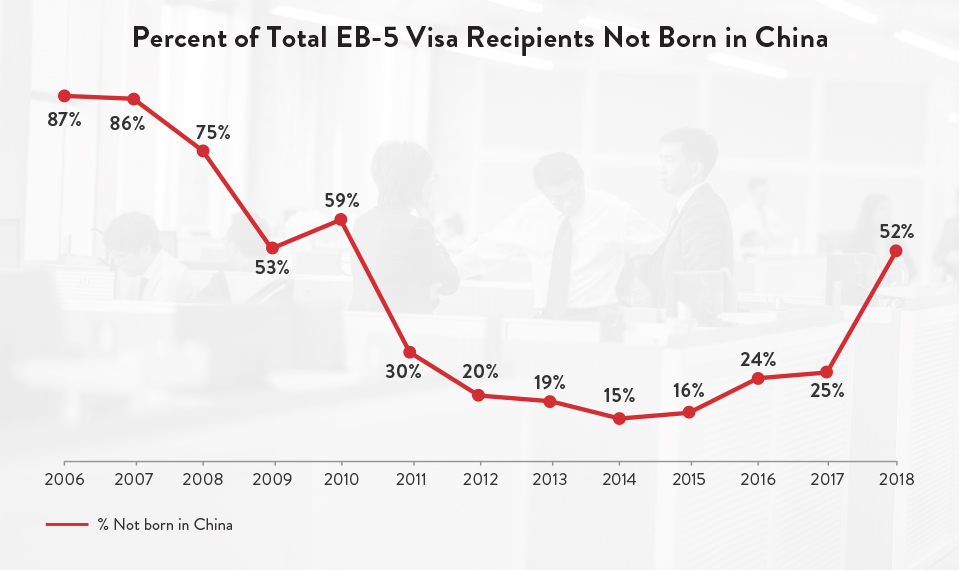Tens of thousands of people have received U.S. Green Cards — a mark of legal, permanent residency — by successfully applying for their EB-5 visa. Sustained interest in this immigration through investment program suggests that global citizens believe EB-5 offers an unparalleled opportunity to participate in the American Dream and begin life in America. If you’d like to be one of these individuals, here are five important first steps to take on your EB-5 journey.

1. Learn the EB-5 basics. The EB-5 visa program was created to spur the U.S. economy and create jobs by allowing foreign investors to put their money into a variety of U.S. investment vehicles. Not only does the EB-5 visa create a direct path to obtaining a U.S. Green Card for investors, but it also extends those same benefits to the investor’s family, including their spouse and any unmarried children under the age of 21.
Chinese citizens have traditionally been the leading investors participating in the EB-5 program. However, in recent years, investors the world over have seized the unique opportunities the program offers. Increasingly, EB-5 visa holders come from Brazil, South Korea, India, Vietnam, Russia, Nigeria and other emerging markets.
A few of the differences between the EB-5 visa and some other well-known types of U.S. immigration are:
- Family members in the U.S. do not need to sponsor investors who want to obtain an EB-5 visa.
- EB-5 applicants do not need to be employed in the U.S.
- EB-5 applicants do need to meet minimum financial investment requirements based on the type of investment.
2. Know the minimum EB-5 investment amount. Currently, those seeking an EB-5 visa can apply with a principal investment of $500,000 for enterprises located in what is known as a Targeted Employment Area (TEA) and $1 million for non-TEA projects. Effective November 21, 2019, however, this minimum amount will nearly double, increasing to $900,000 for TEA and $1.8 million for non-TEA investments. Moreover, since the TEA designation criteria are changing, fewer investment opportunities may qualify at the $900,000 level, making the EB-5 visa an even less affordable option.
Prospective investors weighing an EB-5 investment under the current rules have less than 80 days to act. Barring legislative action, $900,000 will be the new standard for the EB-5 program going forward. Based on Civitas Capital’s conversations with its advocates and allies in Washington, D.C., the possibility of such intervention is remote.
3. Find an investment vehicle. A crucial part of the application process for the EB-5 visa is finding and making an approved investment in the U.S. Investments break down into two broad categories. The first is an investment through a designated Regional Center. The second is an individual investment, which falls under the EB-5 investor’s direct control. Both types of investments require between $500,000 (again, soon to be $900,000) to $1 million (soon to be $1.8 million) in principal investment — depending on investment type and location — and must create at least 10 U.S. jobs.
- Regional Centers. Regional Centers are organizations designated by U.S. Citizenship and Immigration Services (USCIS) to promote economic growth within a defined geography. Projects sponsored by a Regional Center can take credit for direct, indirect, and induced job creation. Direct EB-5 investments can only take credit for direct job creation.
- Direct EB-5 Investment. This is an investment made through the main EB-5 program. It is best suited for the investor who really wants to own and manage a business based in the U.S. The downside of direct investments is that they cannot receive credit for indirect/induced job creation, making it harder for them to meet the EB-5 job creation requirements.
Of note: The Regional Center program, created in 1992, is separate from the main EB-5 program, which was established in 1990. The Regional Center program expired in September 2015 and has been extended through continuing resolutions by the U.S. government. The main EB-5 program is permanent.
4. File an I-526 Petition. Once an EB-5 applicant has found a suitable investment, their immigration attorney files a Form I-526, Immigrant Petition by Alien Entrepreneur. This form serves as the investor’s official petition to the U.S. government for a place in the EB-5 program. It also identifies the investment the EB-5 applicant has made — whether in a Regional Center or via a Direct Investment. Sources for the investment must be carefully and explicitly documented.
It can take more than three years for the government to approve, deny, or request more information regarding the I-526 petition. For this reason, Civitas Capital suggests applicants begin their EB-5 journey as soon as possible.
5. Obtain your conditional U.S. Green Card. If a petitioner’s I-526 is successfully adjudicated, a process known as “retrogression” takes effect. During retrogression, the applicant’s country of origin significantly influences the length of their waiting period. Additionally, application processing times will vary. As of this writing, this application processing takes approximately one calendar year.
To obtain Conditional Permanent Residence status, EB-5 participants must fill out of one of two forms.
- Form I-485, applicable to investors already lawfully living in the U.S.
- Form DS-230, applicable to investors not already living in the U.S.
Conditional Permanent Residence status is valid for two years. Once it has been secured, applicants can begin the process of removing those conditions by completing and submitting Form I-829, Petition by Entrepreneur to Remove Conditions. The I-829 must be filed within the 90-day window immediately before the expiration of conditional residency.
If you would like to discuss the next steps in this journey to American citizenship via the EB-5 Immigrant Investor Program, please fill out the “Contact Us” form below. Best of luck in fulfilling your desire to live the American Dream!
The information and views expressed are for informational purposes only and do not constitute investment advice, a recommendation to buy, hold or sell any security, or a solicitation to purchase or sell any security in any jurisdiction in which such an offer would be unlawful. Nothing in this document should be taken as legal advice regarding immigration, the EB-5 program, or the ability of anyone to meet U.S. immigration requirements and successfully obtain permanent U.S. residency. The status of the EB-5 program and USCIS processing times are subject to change without notice. Individuals should consult with their immigration counsel, financial adviser, or similar representative prior to making any decision.


